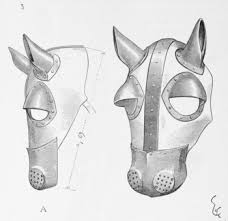


Samnium Protection Chanfrein IVe siècle Bronze Mougins MACM
English Translation
 |
Historique Voir ICI
History Click HERE
Tiré de Wikipedia
Le terme chanfrein est utilisé dans la description anatomique de la tête des animaux pour désigner la partie comprise entre le front et les naseaux ou la truffe du cheval, du chien, du chat, de la vache et de certains autres mammifères à tête allongée.
Par analogie, on nomme également chanfrein la pièce de fer protégeant la tête et le front de l'animal dans le caparaçon.
The chanfron (also spelled chaffron, champion, chamfron, chamfrein, champron, and shaffron) was designed to protect the horse's face. Sometimes this included hinged cheek plates. A decorative feature common to many chanfrons is a rondel with a small spike.The chanfron was known as early as ancient Greece, but vanished from use in Europe until the twelfth century when metal plates replaced boiled leather as protection for war horses. The basic design of the chanfron remained stable until it became obsolete in the seventeenth century, although late examples are often notable for engraved decoration. A chanfron extended from the horse's ears to its muzzle. Flanges often covered the eyes. In an open chanfron, the eyes received no protection. Hinged extensions to cover the jowls were commonly used for jousting tournaments.The enigmatic Torrs pony-cap from Scotland appears to be a bronze chanfron from about the 2nd century BC, perhaps later fitted with the bronze horns found with it.